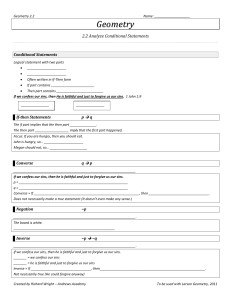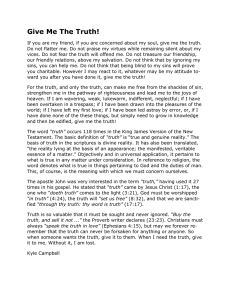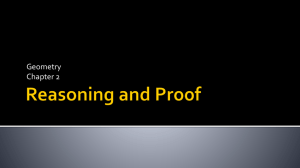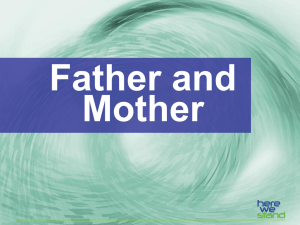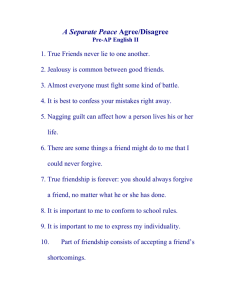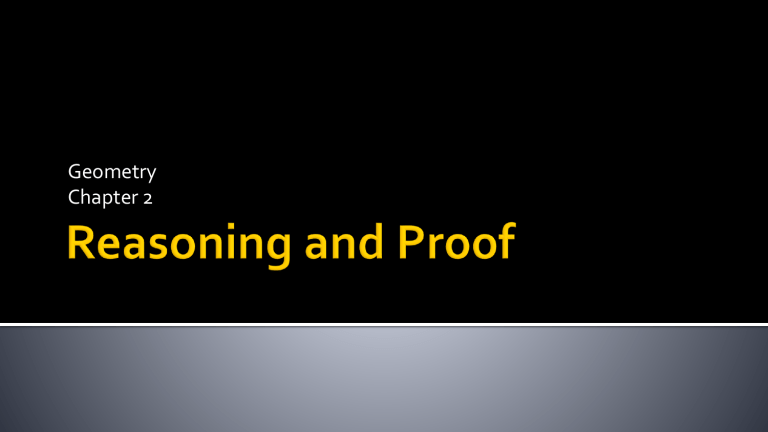
Geometry Chapter 2 This Slideshow was developed to accompany the textbook Larson Geometry By Larson, R., Boswell, L., Kanold, T. D., & Stiff, L. 2011 Holt McDougal Some examples and diagrams are taken from Slides created by the textbook. Richard Wright, Andrews Academy rwright@andrews.edu Geometry, and much of math and science, was developed by people recognizing patterns We are going to use patterns to make predictions this lesson Conjecture Unproven statement based on observation Inductive Reasoning First find a pattern in specific cases Second write a conjecture for the general case Sketch the fourth figure in the pattern Describe the pattern in the numbers 1000, 500, 250, 125, … and write the next three numbers in the pattern Given the pattern of triangles below, make a conjecture about the number of segments in a similar diagram with 5 triangles Make and test a conjecture about the product of any two odd numbers The only way to show that a conjecture is true is to show all cases To show a conjecture is false is to show one case where it is false This case is called a counterexample Find a counterexample to show that the following conjecture is false The value of x2 is always greater than the value of x 75 #5, 6-18 even, 22-28 even, 32, 34, 38-46 even, 47-49 all = 22 total 2.1 Answers 2.1 Homework Quiz Conditional Statement Logical statement with two parts Hypothesis Conclusion Often written in If-Then form If part contains hypothesis Then part contains conclusion If we confess our sins, then He is faithful and just to forgive us our sins. 1 John 1:9 If-then statements pq The if part implies that the then part will happen. The then part does NOT imply that the first part happened. Converse qp Switch the hypothesis and conclusion Example: If we confess our sins, then he is faithful and just to forgive us our sins. ▪ p = we confess our sins ▪ q = he is faithful and just to forgive us our sins Converse = If he is faithful and just to forgive us our sins, then we confess our sins. Does not necessarily make a true statement (It doesn’t even make any sense.) Negation Turn it to the opposite. Example: ▪ The board is white. ~p Inverse ~p ~q Negating both the hypothesis and conclusion Example: If we confess our sins, then he is faithful and just to forgive us our sins. ▪ p = we confess our sins ▪ q = he is faithful and just to forgive us our sins Inverse = If we don’t confess our sins, then he is not faithful and just to forgive us our sins. Not necessarily true (He could forgive anyway) Contrapositive ~q ~p Take the converse of the inverse Example: If we confess our sins, then he is faithful and just to forgive us our sins. ▪ p = we confess our sins ▪ q = he is faithful and just to forgive us our sins Contrapositive (inverse of converse) = If he is not faithful and just to forgive us our sins, then we won’t confess our sins. Always true. Write the following in If-Then form and then write the converse, inverse, and contrapositive All whales are mammals. Biconditional Statement Logical statement where the if-then and converse are both true Written with “if and only if” iff An angle is a right angle if and only if it measure 90°. All definitions can be written as if-then and biconditional statements Perpendicular Lines Lines that intersect to form right angles mr m r Use the diagram shown. Decide whether each statement is true. Explain your answer using the definitions you have learned. 1. JMF and FMG are supplementary 2. Point M is the midpoint of 𝐹𝐻 3. JMF and HMG are vertical angles. 4. 𝐹𝐻 ⊥ 𝐽𝐺 82 #4-20 even, 26, 28, 32, 36-52 even, 53-55 all = 24 total 2.2 Answers 2.2 Homework Quiz Deductive Reasoning Use facts, definitions, properties, laws of logic to form an argument. Deductive reasoning Always true General specific Inductive reasoning Sometimes true Specific general Law of Detachment If the hypothesis of a true conditional statement is true, then the conclusion is also true. Detach means comes apart, so the 1st statement is taken apart. Example: 1. 2. 3. If we confess our sins, then He is faithful and just to forgive us our sins. 1 John 1:9 Jonny confesses his sins God is faithful and just to forgive Jonny his sins 1. 2. 3. If you love me, keep my commandments. I love God. ____________________________________ 1. 2. 3. If you love me, keep my commandments. I keep all the commandments. ____________________________________ Law of Syllogism If hypothesis p, then conclusion q. If hypothesis q, then conclusion r. If hypothesis p, then conclusion r. 1. 2. 3. If these statement are true, then this statement is true If we confess our sins, He is faithful and just to forgive us our sins. If He is faithful and just to forgive us our sins, then we are blameless. If we confess our sins, then we are blameless. If you love me, keep my commandments. If you keep my commandments, you will be happy. ______________________________________ If you love me, keep my commandments. If you love me, then you will pray. ______________________________________ 90 #4-12 even, 16-28 even, 30-38 all = 20 total Extra Credit 93 #2, 4 = +2 total 2.3 Answers 2.3 Homework Quiz Postulates (axioms) Rules that are accepted without proof (assumed) Theorem Rules that are accepted only with proof Basic Postulates (Memorize for quiz!) Through any two points there exists exactly one line. A line contains at least two points. If two lines intersect, then their intersection is exactly one point. Through any three noncollinear points there exists exactly one plane. Basic Postulates (continued) A plane contains at least three noncollinear points. If two points lie in a plane, then the line containing them lies in the plane. If two planes intersect, then their intersection is a line. Which postulate allows you to say that the intersection of plane P and plane Q is a line? Use the diagram in Example 2 to write examples of Postulates 5, 6, and 7. P B C Interpreting a Diagram A You can Assume All points shown are coplanar AHB and BHD are a linear pair AHF and BHD are vertical angles A, H, J, and D are collinear 𝐴𝐷 and 𝐵𝐹 intersect at H G H F J E D You cannot Assume G, F, and E are collinear 𝐵𝐹 and 𝐶𝐸 intersect 𝐵𝐹 and 𝐶𝐸 do not intersect BHA CJA 𝐴𝐷 ⊥ 𝐵𝐹 mAHB = 90° Sketch a diagram showing 𝐹𝐻 ⊥ 𝐸𝐺 at its midpoint M. Which of the follow cannot be assumed. A, B, and C are collinear 𝐸𝐹 line ℓ 𝐵𝐶 plane ℛ 𝐸𝐹 intersects 𝐴𝐶 at B line ℓ 𝐴𝐵 Points B, C, and X are collinear ℛ E A X C B ℓ F 𝒮 99 #2-28 even, 34, 40-56 even = 24 total 2.4 Answers 2.4 Homework Quiz When you solve an algebra equation, you use properties of algebra to justify each step. Segment length and angle measure are real numbers just like variables, so you can solve equations from geometry using properties from algebra to justify each step. Property of Equality Numbers Segments Angles Reflexive a=a AB = AB m1 = m1 Symmetric a = b, then b = a AB = CD, then CD = AB m1 = m2, then m2 = m1 Transitive a = b and b = c, then a = c AB = BC and BC = CD, then AB = CD m1 = m2 and m2 = m3, then m1 = m3 Add and Subtract If a = b, then a+c= b+c AB = BC, then AB + DE = BC + DE m1 = m2, then m1 + m3 = m2 + m3 Multiply and divide If a = b, then ac = bc AB = BC, then 2AB = 2BC m1 = m2, then 2m1 = 2m2 Substitution If a = b, then a may be replaced by b in any equation or expression Distributive a(b + c) = ab + ac Name the property of equality the statement illustrates. If m6 = m7, then m7 = m6. If JK = KL and KL = 12, then JK = 12. mW = mW Solve the equation and write a reason for each step 14x + 3(7 – x) = -1 Solve A = ½ bh for b. Given: mABD = mCBE Show that m1 = m3 A C B 1 2 3 D E 108 #4-34 even, 39-42 all = 20 total Extra Credit 111 #2, 4 = +2 2.5 Answers 2.5 Homework Quiz Pay attention today, we are going to talk about how to write proofs. Proofs are like starting a campfire (I heat my house with wood, so knowing how to build a fire is very important.) Given: A cold person out in the woods camping with newspaper and matches in their backpack Prove: Start a campfire Congruence of segments and angles is reflexive, symmetric, and transitive. Writing proofs follow the same step as the fire. 1. 2. 3. 4. 5. 6. Write the given and prove written at the top for reference Start with the given as step 1 The steps need to be in an logical order You cannot use an object without it being in the problem Remember the hypothesis states the object you are working with, the conclusion states what you are doing with it If you get stuck ask, “Okay, now I have _______. What do I know about ______ ?” and look at the hypotheses of your theorems, definitions, and properties. Complete the proof by justifying each Given: Points P,Q, R, and S are collinear Prove: PQ = PS – QS P Q R Statements Reasons Points P,Q, R, and S are Given collinear PS = PQ + QS Segment addition post PS – QS = PQ Subtraction PQ = PS – QS Symmetric S Write a two column proof A B C Given: 𝐴𝐶 ≅ 𝐷𝐹, 𝐴𝐵 ≅ 𝐷𝐸 Prove: 𝐵𝐶 ≅ 𝐸𝐹 D E F 116 #2-12 even, 16, 18, 22-26 even, 30-36 all = 18 total 2.6 Answers 2.6 Homework Quiz All right angles are congruent Congruent Supplements Theorem If two angles are supplementary to the same angle (or to congruent angles), then they are congruent Congruent Complements Theorem If two angles are complementary to the same angle (or to congruent angles), then they are congruent Linear Pair Postulate If two angles form a linear pair, then they are supplementary Vertical Angles Congruence Theorem Vertical angles are congruent Find x and y 3x - 2 2x + 4 y ℓ Given: ℓ m, ℓ n Prove: 1 2 Statements Reasons 2 1 m n Given: 81 7 2 6 3 54 1 and 3 are complements 3 and 5 are complements Prove: 1 5 Statements Reasons 127 #2-28 even, 32-46 even, 50, 52 = 24 total Extra Credit 131 #2, 4 = +2 2.7 Answers 2.7 Homework Quiz 138 #1-21 = 21 total
